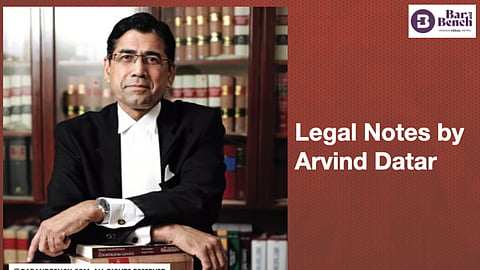
- Latest Legal News
- News
- Dealstreet
- Viewpoint
- Columns
- Interviews
- Law School
- Legal Jobs
- हिंदी
- ಕನ್ನಡ

The principle that statutes operate only prospectively has its origin in Roman law. This principle was later made part of English common law by Coke and also accepted by Blackstone’s commentaries, published in 1765. This principle is also based on common sense and logic. A statute will not apply to events that have already taken place, unless the legislature expressly declares the law to be retrospective.
However, based on Blackstone’s commentaries, the traditional view has been that a judgment of a court operates retrospectively. If a decision is overruled or a statutory provision declared invalid, then the judgment takes effect from the date of the earlier decision or the date when the statute was enacted.
This view has the potential to create hardship on citizens and corporations would have acted on the basis of the prevailing law. Courts have, in some cases, declared that their judgments would operate prospectively.
In 1848, the Supreme Court of Ohio declared certain provisions relating to divorces as invalid but made its judgment prospective. The traditional view of retrospective application of a court ruling would have rendered several second marriages invalid and, worse, made children born of such marriages illegitimate. [Bingham v. Miller, 17 Ohio 445 (1848)]
In 1863, the US Supreme Court refused to give retrospective effect to a judgement of the Supreme Court of Iowa that had declared municipal bonds invalid. To do so would have caused serious hardship as these were purchased on the basis of the earlier law [Gelpcke v. City of Dubuque]. The leading case on this subject is Great Northern Railway Co v. Sunburst Oil and Refining Co and the doctrine of prospective overruling is called the “Sunburst Doctrine”.
In India, the doctrine was first applied by a bench of 11 judges in Golak Nath v. State of Punjab. This was necessary because the declaration that Parliament could not amend or abridge the provisions of Part III would have rendered important constitutional amendments invalid and, consequently, numerous land reform laws would be invalid as well.
While prospective overruling mitigated hardship by protecting past transactions, a judgment overruling past judgments takes effect the day it is delivered. This can create a different kind of hardship because of the after-effects of overturning the law that has prevailed for several years.
The courts in the US have thus crafted the doctrine of prospective prospective overruling, whereby the application of the new judgment is also made prospective by postponing the day it comes into effect.
In 1961, the Supreme Court of Wisconsin abolished the rule of sovereign immunity from tortious liability. But it did so prospectively. It then further postponed such abolition by a year to enable various public bodies to make suitable financial arrangements to meet the liabilities that would arise from the new ruling.
A prominent example of the doctrine’s application may be found in the historic Brown v. Board of Education case. The Court held that state-sanctioned segregation in schools violated the Equal Protection Clause of the United States Constitution. Ordinarily, such unconstitutional state action would require immediate cessation. However, in light of the substantial legislative and legal adjustments necessitated by this ruling, the United States Supreme Court fashioned an equitable remedy by instructing district courts to undertake appropriate proceedings and issue orders and decrees, consistent with its opinion, to ensure the admission of the parties to public schools on a racially nondiscriminatory basis “with all deliberate speed.” This phrase permitted the constitutional shift to be implemented gradually, allowing the Court’s decision to take effect in a measured, incremental manner.
In India, the Supreme Court in Indra Sawhney had adopted an approach consistent with prospective prospective overruling, although this expression was not used. While interpreting Article 16(4-A) and its implications for reservation in promotions, the Supreme Court in Indra Sawhney held that the provision does not grant reservation in matters of promotion. In this landmark ruling, the Supreme Court saved all promotions made prior to the judgment, regardless of whether those promotions were temporary, officiating, or permanent. Furthermore, the Court permitted provisions providing for reservation in promotions within Central and State services to remain in effect for a transitional period of five years from the date of the judgment. In this period, the Court stated that it would be open for the appropriate authorities to revise, modify, or re-issue the relevant rules to ensure that the objective behind Article 16(4) is achieved. See also Jarnail Singh v. Lachhmi Narain Gupta.
In an excellent article titled Quo Vadis, Prospective Overruling: A Question of Judicial Responsibility, 28 Hastings L.J. 533 (1977), Chief Justice Traynor pointed out that this doctrine may also give time to the legislature to suitably amend the law, even retrospectively, to enable an orderly transition and to balance the advantages and hardships that may be faced by different sections of society. This is the balancing that the judiciary cannot do. On this subject, the reader may also refer to Prospective-Prospective Overruling, Minnesota Law Review 78 (1966).
This doctrine is an excellent technique that can be applied while overruling an earlier decision or even when striking down a statute as unconstitutional. The court can, on the facts of a particular case, make the prospective overruling prospective and to take effect at a later date.
Arvind P Datar is a Senior Advocate.
The author thanks M Jannani, Advocate, Madras High Court for research on this subject.